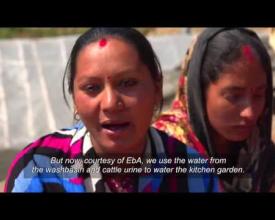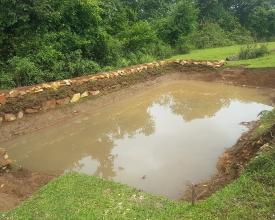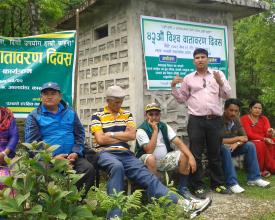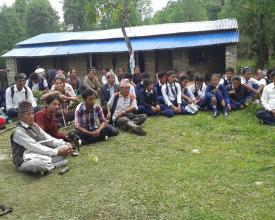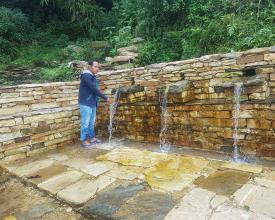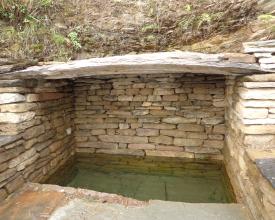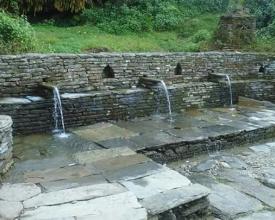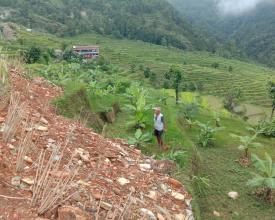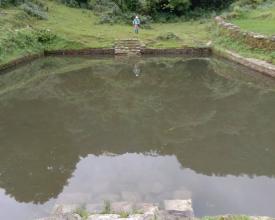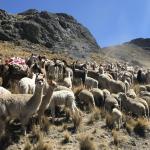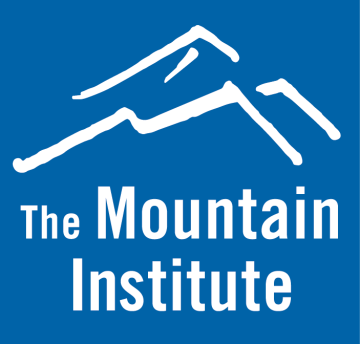
Using local knowledge to improve water availability in Panchase, Nepal
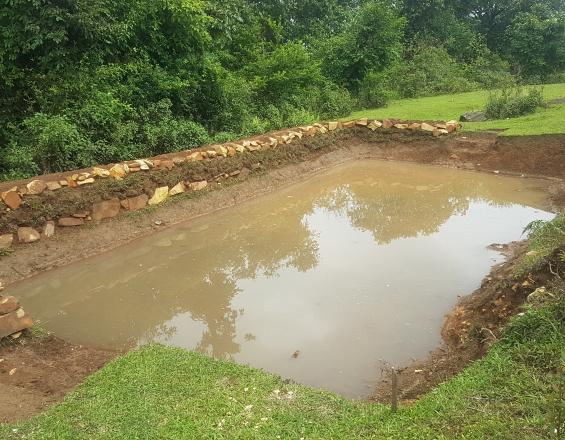
Traditionally, the people living in the area around Panchase had natural water sources, i.e. ponds and water sources that provided water for the community, travelers, and wild and domesticated animals. These natural areas also provided ecosystem benefits including ground water retention and regeneration and habitat for many types of plants and animals, including certain trees with religious significance for the community. Development in recent years has obstructed the water sources for these ponds and natural sources; in some cases, ponds have been built over. Using locally available resources such as mud, stones, and slate, community members have fortified streambanks, cleared weed overgrowth, and removed debris around the water sources. They also planted vegetation with high water-retention and soil-holding capacities. These measures were designed using EbA principles, with an emphasis on utilising local resources, integrating local knowledge, and engaging local people.
Contexto
Défis à relever
- Disturbance and damage of traditional water resource infrastructure
- Sedimentation and landslides
- Water shortages due to depletion of water resources
- Degradation of water quality due to increasing anthropogenic activity within the periphery of the water resources
- Labour shortage due to emigration of young people from the villages
- Disconnection and lack of coordination between community organizations
- Loss of biodiversity due to droughts
- Degraded wetlands due to open grazing
- Erosion during the monsoon season due to poor road construction and unplanned trails. Shallow slope failure and debris flows result, leading to disintegration of the aquatic ecosystem.
- Low level of awareness about the ecological, social, and economic importance of water resources
Ubicación
Procesar
Summary of the process
Traditional knowledge about methods to increase water retention and infiltration exist in Panchase in the form of water ponds and water sources. This measure uses three building blocks – creating awareness about EbA (I), promoting green infrastructure (II), and reducing water runoff (III) – to address the water availability challenges faced by the community. The building blocks reinforce one other, thereby increasing effectiveness and sustainability. The integration of local and scientific knowledge in Building Blocks I and II ensures that the community is self-reliant in maintaining the ponds and water sources. The use of locally available materials increases the community’s confidence in its ability to afford and maintain the measure. The process of prioritising restoration sites facilitates local ownership of the project, as people feel empowered to make the changes they feel are most needed. Further, the religious significance of the ponds and the social benefit of communal resting spaces provide further motivation to maintain the ponds. Building Blocks I and II create an environment for the effective application of the third building block, which directly addresses an existing and recognized community need.
Building Blocks
Creating awareness and knowledge about EbA
Because Ecosystem-based Adaptation (EbA) was a completely new concept to the stakeholders and communities, it was essential to build awareness about EbA and its potential benefits. Prior to this, the communities’ model of development was deforestation and overexploitation of plant species, which negatively impacted biodiversity. Training on EbA was first given to local partner organisations and then to community members, with a focus on how the EbA approach addresses climate change and helps communities address other issues such as income generation. After the trainings, a series of awareness-raising activities were conducted, including the publication of brochures, signboards, posters, and other materials. The objective was to demonstrate the different activities to be implemented, such as conservation of community water ponds, and their positive impacts. After creating awareness about the EbA concept and its practice, the community took a leadership role in implementing activities and was empowered to integrate their local knowledge and skills in water source and pond conservation. Technical experts supported the communities’ local knowledge with technical and scientific expertise.
Enabling factors
- Active participation of governing bodies, implementing agencies, local communities and other stakeholders
- Communication tools such as interactive maps, posters, and videos
- Integration of local knowledge and past experience in the construction of ponds (type of materials, suitable locations, etc.)
- Practical demonstration of activities
- Promotion of citizen scientists as bridges between the project and local communities
- Communities leading implementation
Lesson learned
- Community engagement is crucial. In Panchase, the project targeted engaged community leaders, who in turn motivated other community members to participate.
- Participation of diverse groups increases the potential for success and the equitable distribution of benefits. The project sought the participation of community forest user groups and other community groups, including mothers’ group, homestay groups, and agricultural groups.
- The project team should have a clear understanding of the environmental, socio-economic, and political context of the area. Tourism in Panchase helped determine the intervention. Increasing the viability of homestays provided an entry point for additional measures.
- Maintaining a good rapport with communities and stakeholders fosters trust. Both IUCN and the local NGO regularly visited the site and communities and developed a strong rapport through frequent positive interactions.
- Local knowledge: the project used the communities’ local knowledge about pond restoration, water conservation, and water management to develop the intervention.
Promotion of green infrastructure using local resources
The first step of this measure was to collect information about existing water resources, as well as to explore the potential for new water bodies within the sites. Using maps, direct field observations, and community input, the project mapped different water bodies. Further, resources were prioritised on the basis of site vulnerability, extent of potential damage, possibility of groundwater recharge, risk of water-induced disaster, risk of water scarcity, and priority for the communities. After prioritization, the project used easily available local resources to rehabilitate ponds and water sources. The project staff, local government, and communities applied their knowledge (both traditional and technical) to rehabilitate ponds and water sources. The use of context-specific, locally available, and affordable materials (such as bamboo) helped to promote the sustainability of the intervention.
Enabling factors
- Establishing trust within local communities and between the communities and the project team
- Communities’ active leadership and involvement in the implementation of activities is crucial for developing a sense of project ownership
- Use of local knowledge and resources
- Community labour contribution
- Financial contribution of the project to the activities
- Promotion of infrastructure based on the degree of vulnerability and community prioritisation
Lesson learned
- Community interest and participation plays a key role in the successful implementation of activities
- Advance planning with clear roles and responsibilities helps ensure the successful implementation of activities
- Integrating local knowledge with scientific knowledge is more effective than applying a purely technical approach
- It is essential that the communities’ priorities are respected and integrated into the design of the measures
- Working with groups is more effective than working with individuals
- Community leadership and labour contribution in building infrastructure creates ownership and commitment within the communities
- Using local resources to promote green infrastructure is more cost-effective, faster, and more sustainable
- The integration of a variety of complementary activities, such as planting species that promote water recharge within the periphery of rehabilitated water infrastructure is sustainable and effective
Reducing water runoff
The purpose of restoring water sources, especially community ponds, is to increase water infiltration by lowering the rate and volume of water runoff during the rainy season and to store rainwater for use during the dry season. The project supported the protection, repair, and rehabilitation of springs and old ponds, thereby improving the water supply. Panchase receives a high volume of rainfall during the rainy season, so these ponds store water for later use rather than letting it run off. This water is used well into the dry season to irrigate crops and as drinking water for domestic and wild animals. By reducing runoff, the project also reduced soil erosion and landslides in the area. Additionally, the measure increased water infiltration and contributed to ground water recharge, which benefits areas downstream, as well as the overall ecosystem.
Enabling factors
- Technical knowledge of water source restoration before engaging the community groups in implementation of activities
- A strong rapport between the communities and the project team
- The project focused on developing measures that addressed issues already considered problematic by the communities, which helped ensure strong community support for the measures
- Ponds were chosen for restoration based on priorities determined by the communities themselves
Use of local knowledge regarding water source location and resource use
Lesson learned
- Using a participatory approach to address community problems ensures more interest in and ownership of project interventions
- Handing over the project implementation responsibility to community groups increases community ownership and commitment, but technical and managerial training must be provided before transferring responsibility
- Perennial water sources are necessary to ensure a year-round supply of water and therefore effective water-retention.
- Interventions should be integrated with other relevant activities, such as agriculture, to ensure sustainability
- To protect community ponds from damage due to rural road construction, it is important to enforce appropriate safeguard measures
Impacts
Environmental Impact
- Increased water infiltration, reduced rate and volume of water run-off from the watershed
- Reduced water-related disasters, including soil erosion and landslides
- Contribution to groundwater recharge and water sprouting downstream, especially during dry season
- Improved soil conditions, mainly due to increased soil moisture content
- Increased vegetation, air quality, growth of trees and other species near water sources along the water catchment and downstream area
- Contribution to the conservation of both aquatic and terrestrial ecosystems
- Promotion of a healthy environment
- Reduced incidence of forest fires
Social Impact
- Increased motivation to engage in agriculture and livestock production activities due to increased water availability
- Creation of opportunities for irrigation and cultivation of agroforestry species, crops, and off-season vegetables, especially during dry season
- Increased social cohesiveness
- Enhanced local cultural and religious importance of water ponds and rest areas
- Reduced risk of landslides for local communities
- Reduced losses as a result of forest fires
Economic Impact
- Contribution to ecotourism through increased natural beauty
- Creation of job opportunities from agriculture and other on-farm activities
- Contribution to human health and nutrition
- Increased household incomes
Beneficiaries
- Direct: 500 rural households (approx. 2500 people) living in the Harpan Khola Sub watershed
- Indirect: Communities upstream and downstream from the Panchase Protected Forest
Sustainable Development Goals
Story
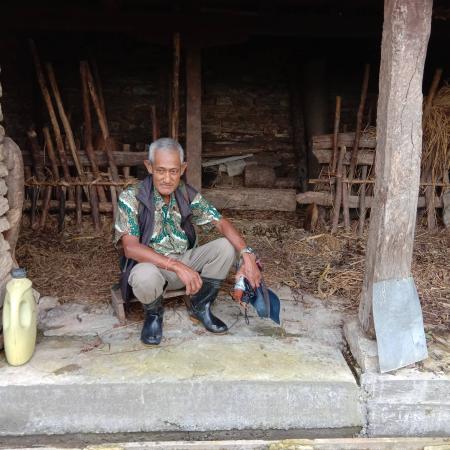
People in Panchase have traditionally relied on ponds called Pokhari for their water needs. The Pokhari also have religious significance, and pipal trees (Ficus religiosa) were often planted around them and worshiped. Traditionally, communities built resting places called chautari around the ponds. These were often built near trekking trails, so travellers could rest. Villagers used chautari for their livestock and as community meeting areas. The waters of chautari are also significant for some cultural festivals such as the chhat festival in Terai and bala chaturdasi in the hilly areas of Nepal.
In his 70 years of life, Mr. Guman Singh Gurung has witnessed a lot of ecological and socio-economic changes in his community. The village now has a road, electricity, tap water, homestay businesses, and small hotels for tourists. However, there have also been some negative changes. People are emigrating from the villages and most of the agricultural land is abandoned. With increasing reliance on tap water, the ponds became neglected. Many were overgrown with weeds and the flow of water to others was obstructed by sedimentation from road construction. In addition, changing rainfall patterns, increasing temperatures, declining water resources, and invasive species are harming the ecosystem. Significant climatic and environmental changes have affected water availability and reduced soil water content, increasing the risk of forest fires. Rehabilitating community ponds and the sources of spring water that fill them helps address the issues that Mr. Gurung and other members of his community face.
Combining science and local knowledge, technical experts and community members worked together to restore the ponds. They used local materials such as stone, slate, mud, and bamboo for the restoration. Guman sees many benefits from the increased availability of water, including a diversity of livelihood opportunities such as off-season farming. These measures also help improve groundwater recharge, soil moisture, and water availability downstream and during the dry season, increasing the communities’ capacity to adapt to climate change.

